Related Research Articles

Ruthin is a market town and community in Denbighshire, Wales, in the south of the Vale of Clwyd. It is Denbighshire's county town. The town, castle and St Peter's Square lie on a hill, skirted by villages such as Pwllglas and Rhewl. The name comes from the Welsh rhudd (red) and din (fort), after the colour of sandstone bedrock, from which the castle was built in 1277–1284. The Old Mill, Ruthin, is nearby. Maen Huail, a registered ancient monument attributed to the brother of Gildas and King Arthur, stands in St Peter's Square.
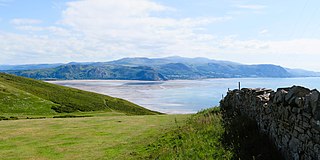
Conwy County Borough is a county borough in the north of Wales. It borders Gwynedd to the west and south and Denbighshire to the east. The largest settlement is Colwyn Bay, and Conwy is the administrative centre.

Denbighshire is a county in the north-east of Wales. It borders the Irish Sea to the north, Flintshire to the east, Wrexham to the southeast, Powys to the south, and Gwynedd and Conwy to the west. Rhyl is the largest town, and Ruthin is the administrative centre. Its borders differ from the historic county of the same name.
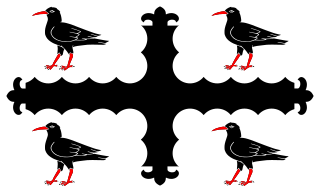
Flintshire, also known as the County of Flint, is one of Wales' thirteen historic counties, and a former administrative county. It mostly lies on the north-east coast of Wales.

The River Clwyd is a river in Wales that rises in the Clocaenog Forest 5 mi (8 km) northwest of Corwen. Its total length is 35 mi (56 km).
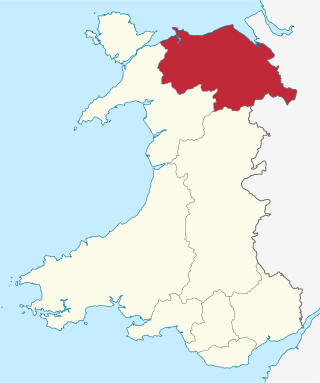
Clwyd is a preserved county of Wales, situated in the north-east corner of the country; it is named after the River Clwyd, which runs through the area. To the north lies the Irish Sea, with the English ceremonial counties of Cheshire to the east and Shropshire to the south-east. Powys and Gwynedd lie to the south and west respectively. Clwyd also shares a maritime boundary with Merseyside along the River Dee. Between 1974 and 1996, a slightly different area had a county council, with local government functions shared with six district councils. In 1996, Clwyd was abolished, and the new principal areas of Conwy County Borough, Denbighshire, Flintshire and Wrexham County Borough were created; under this reorganisation, "Clwyd" became a preserved county, with the name being retained for certain ceremonial functions.

Clwyd West is a constituency of the House of Commons of the Parliament of the United Kingdom. It elects one Member of Parliament (MP) by the first past the post method of election. The current MP is David Jones of the Conservative Party, first elected at the 2005 general election and who also served as Secretary of State for Wales from 4 September 2012 until 14 July 2014.
The Vale of Clwyd is a tract of low-lying ground in the county of Denbighshire in north-east Wales. The Vale extends south-southwestwards from the coast of the Irish Sea for some 20 miles forming a triangle of low ground bounded on its eastern side by the well-defined scarp of the Clwydian Range and to the west by numerous low hills. The River Clwyd which rises within Clocaenog Forest, southwest of Denbigh, runs the full length of the vale. It is joined by the two major left bank tributaries of the River Clywedog and River Elwy and the smaller right bank tributary of the River Wheeler.

The Clwydian Range is a series of hills in the north-east of Wales that runs from Llandegla in the south to Prestatyn in the north; the highest point is 554 m (1,818 ft) Moel Famau. The range forms the north-western part of the Clwydian Range and Dee Valley Area of Outstanding Natural Beauty.

The Lledr Valley is a valley in Snowdonia in north Wales. It runs from the top of the Crimea Pass, north of Blaenau Ffestiniog down to Betws-y-Coed.

Denbigh Moors is an upland region in Conwy and Denbighshire in north-east Wales, between Snowdonia and the Clwydian Range. It includes the large reservoirs Llyn Brenig and Llyn Alwen, and the Clocaenog Forest, which has one of Wales's last populations of red squirrels. It also contains the open heath Hafod Elwy Moor National Nature Reserve.
The Clwydian Way is a waymarked long-distance footpath in north-east Wales, mostly running through Denbighshire.
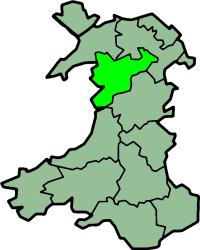
Edeirnion or Edeyrnion is an area of the county of Denbighshire and an ancient commote of medieval Wales in the cantref of Penllyn. According to tradition, it was named after its eponymous founder Edern or Edeyrn. It was included as a Welsh territory of Shropshire in the Domesday Book.

St Mary's Church, Betws Gwerful Goch, is in the village of Betws Gwerful Goch, Denbighshire, Wales. It is an active Anglican church in the deanery of Penllyn & Edeyrnion, the archdeaconry of Wrexham and the diocese of St Asaph. The church is designated by Cadw as a Grade II* listed building.

Betws Gwerfil Goch is a village and community in Denbighshire, Wales. It had a population of 351 at the 2011 census. Until 1974 it was part of Edeirnion Rural District in Meirionnydd, and was transferred to Glyndŵr District in Clwyd by the Local Government Act 1972. It became part of Denbighshire in 1996. The community includes Melin-y-Wig village.
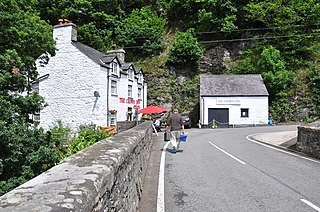
Llanfihangel Glyn Myfyr is a village and community in Conwy County Borough, in Wales. It is located within the historic county of Denbighshire on the Afon Alwen, at the south western edge of the Clocaenog Forest, 9.1 miles (14.6 km) north west of Corwen, 2.5 miles (4.0 km) east of Cerrigydrudion and 27.5 miles (44.3 km) south of Conwy. At the 2001 census the community had a population of 195, reducing to 189 at the 2011 census.
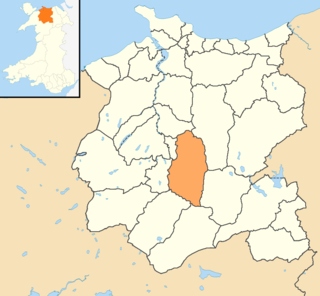
Bro Garmon is a sparsely populated community in Conwy County Borough, in Wales. It is located on the eastern side of the Conwy Valley, stretching from north east of Llanrwst to just west of Pentrefoelas, and includes the villages of Capel Garmon, Glan Conwy, Melin-y-Coed, Nebo, Oaklands, Rhydlanfair and Pentre-tafarn-y-fedw. Moel Seisiog, on the eastern boundary, rises to a height of 1,535 feet (468 m). The main settlement, Capel Garmon, lies 2.4 miles (3.9 km) east of Betws-y-Coed, 5.2 miles (8.4 km) north west of Pentrefoelas, 4.4 miles (7.1 km) south of Llanrwst and 15.7 miles (25.3 km) south of Conwy. At the 2001 census the community had a population of 648, increasing slightly at the 2011 census to 652.
Edward Samuel, Welsh clergyman, poet and translator, was encouraged by Humphrey Humphreys, then bishop of Bangor, to train for the ministry, which he undertook at Oriel College, Oxford, from where, according to Thomas's History of the Diocese of St. Asaph, he graduated on 19 May 1693. He held in succession the Denbighshire livings of Betws Gwerfil Goch 1702–1721 and Llangar 1721–1748, with the latter held concomitantly from 1735 to 1747 with that of Llanddulas. His two sons followed him in the ministry.
References
- ↑ "River Clwyd | river, Wales, United Kingdom | Britannica". www.britannica.com. Retrieved 2022-11-30.
- ↑ Brown, E. H.; Harris, A. N. (1969). "Drainage Diversions in the Upper Clwyd Valley". Geography. 54 (2): 140–151. ISSN 0016-7487. JSTOR 40566780.
- ↑ "Ysgol Betws Gwerfil Goch". Denbighshire County Council. Retrieved 7 June 2020.
- ↑ Pedersen, Torben (2005). "HTTPS, Secure HTTPS". Encyclopedia of Cryptography and Security. pp. 268–269. doi:10.1007/0-387-23483-7_189. ISBN 978-0-387-23473-1.
- ↑ "Dinas Melin-y-Wig, Betws Gwerfil Goch (Betws Gwerful Goch), Denbighshire (Sir Ddinbych)". ancientmonuments.uk. Retrieved 2022-11-30.
![]() This article incorporates text published under the British Open Government Licence : "Scheduled Monuments- Full Report – Dinas Melin-y-Wig". Llywodraeth Cymru. Retrieved November 8, 2022.
This article incorporates text published under the British Open Government Licence : "Scheduled Monuments- Full Report – Dinas Melin-y-Wig". Llywodraeth Cymru. Retrieved November 8, 2022.